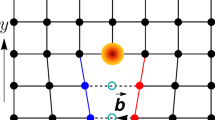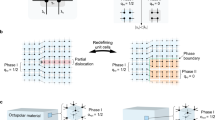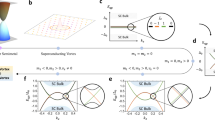Abstract
Topological defects, such as domain walls and vortices, have long fascinated physicists. A novel twist is added in quantum systems such as the B-phase of superfluid helium He3, where vortices are associated with low-energy excitations in the cores. Similarly, cosmic strings may be tied to propagating fermion modes. Can analogous phenomena occur in crystalline solids that host a plethora of topological defects? Here, we show that indeed dislocation lines are associated with one-dimensional fermionic excitations in a ‘topological insulator’, a novel phase of matter believed to be realized in the material Bi0.9Sb0.1. In contrast to fermionic excitations in a regular quantum wire, these modes are topologically protected and not scattered by disorder. As dislocations are ubiquitous in real materials, these excitations could dominate spin and charge transport in topological insulators. Our results provide a novel route to creating a potentially ideal quantum wire in a bulk solid.
This is a preview of subscription content, access via your institution
Access options
Subscribe to this journal
Receive 12 print issues and online access
$209.00 per year
only $17.42 per issue
Buy this article
- Purchase on Springer Link
- Instant access to full article PDF
Prices may be subject to local taxes which are calculated during checkout




Similar content being viewed by others
References
Kane, C. L. & Mele, E. J. Quantum spin hall effect in graphene. Phys. Rev. Lett. 95, 226801 (2005).
Kane, C. L. & Mele, E. J. Z2 topological order and the quantum spin Hall effect. Phys. Rev. Lett. 95, 146802 (2005).
Bernevig, B. A. & Zhang, S.-C. Quantum spin Hall effect. Phys. Rev. Lett. 96, 106802 (2006).
Fu, L., Kane, C. L. & Mele, E. J. Topological insulators in three dimensions. Phys. Rev. Lett. 98, 106803 (2007).
Moore, J. E. & Balents, L. Topological invariants of time-reversal-invariant band structures. Phys. Rev. B 75, 121306 (2007).
Roy, R. Three dimensional topological invariants for time reversal invariant Hamiltonians and the three dimensional quantum spin Hall effect. Preprint at <http://arxiv.org/abs/cond-mat/0607531> (2006).
Bernevig, B. A., Hughes, T. L. & Zhang, S.-C. Quantum spin Hall effect and topological phase transition in HgTe quantum wells. Science 314, 1757–1761 (2006).
Koenig, M. et al. Quantum spin Hall insulator state in HgTe quantum wells. Science 318, 766–770 (2007).
Wu, C., Bernevig, B. A. & Zhang, S.-C. Helical liquid and the edge of quantum spin Hall systems. Phys. Rev. Lett. 96, 106401 (2006).
Xu, C. & Moore, J. E. Stability of the quantum spin hall effect: Effects of interactions, disorder, and Z2 topology. Phys. Rev. B 73, 045322 (2006).
Hsieh, D. et al. A topological Dirac insulator in a quantum spin hall phase. Nature 452, 970–974 (2008).
Fradkin, E., Dagotto, E. & Boyanovsky, D. Physical realization of the parity anomaly in condensed matter physics. Phys. Rev. Lett. 57, 2967–2970 (1986).
Nakahara, M. Geometry, Topology and Physics (Institute of Physics, 2003).
Jackiw, R. & Rossi, P. Zero modes of the vortex-fermion system. Nucl. Phys. B 190, 681–691 (1981).
Kohmoto, M., Halperin, B. I. & Wu, Y.-S. Diophantine equation for the three-dimensional quantum Hall effect. Phys. Rev. B 45, 13488–13493 (1992).
Carpentier, D., LeDoussal, P. & Giamarchi, T. Stability of the Bragg glass phase in a layered geometry. Europhys. Lett. 35, 379–384 (1996).
Teo, J. C. Y., Fu, L. & Kane, C. L. Surface states and topological invariants in three-dimensional topological insulators: Application to Bi1−xSbx . Phys. Rev. B 78, 045426 (2008).
Fu, L. & Kane, C. L. Superconducting proximity effect and majorana fermions at the surface of a topological insulator. Phys. Rev. Lett. 100, 096407 (2008).
Acknowledgements
We acknowledge financial support from NSF DMR-0645691 and thank C. Kane and J. Orenstein for discussions.
Author information
Authors and Affiliations
Corresponding author
Rights and permissions
About this article
Cite this article
Ran, Y., Zhang, Y. & Vishwanath, A. One-dimensional topologically protected modes in topological insulators with lattice dislocations. Nature Phys 5, 298–303 (2009). https://doi.org/10.1038/nphys1220
Received:
Accepted:
Published:
Issue Date:
DOI: https://doi.org/10.1038/nphys1220
This article is cited by
-
Dislocation Majorana bound states in iron-based superconductors
Nature Communications (2024)
-
Recent progress in the role of grain boundaries in two-dimensional transition metal dichalcogenides studied using scanning tunneling microscopy/spectroscopy
Applied Microscopy (2023)
-
Three-dimensional non-Abelian Bloch oscillations and higher-order topological states
Communications Physics (2023)
-
Emergent metallicity at the grain boundaries of higher-order topological insulators
Scientific Reports (2023)
-
Topological phenomena at defects in acoustic, photonic and solid-state lattices
Nature Reviews Physics (2023)



